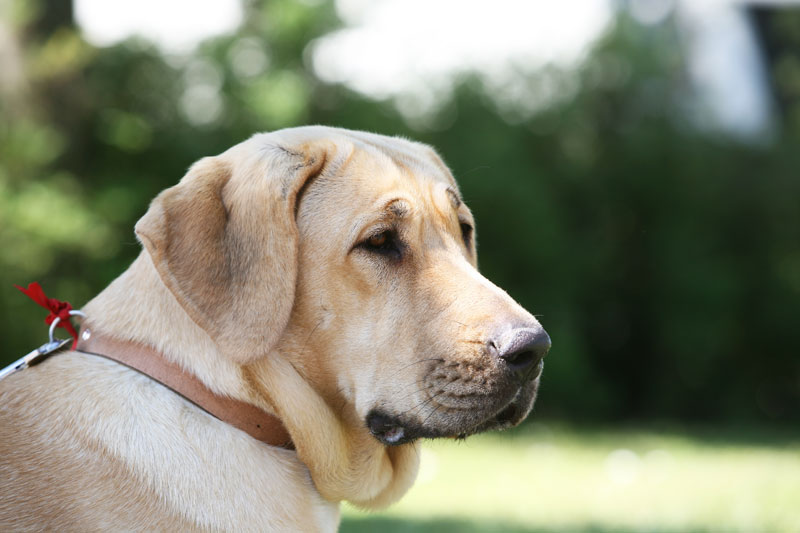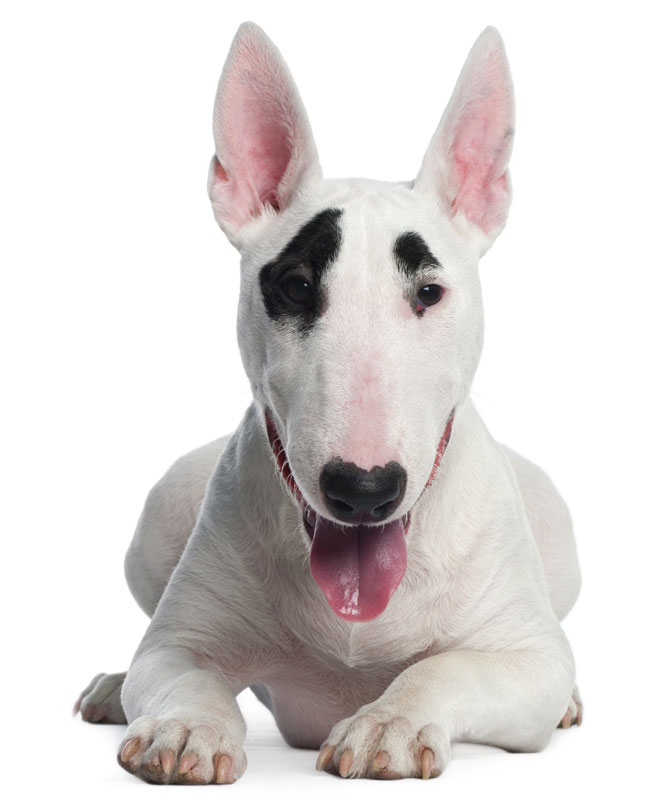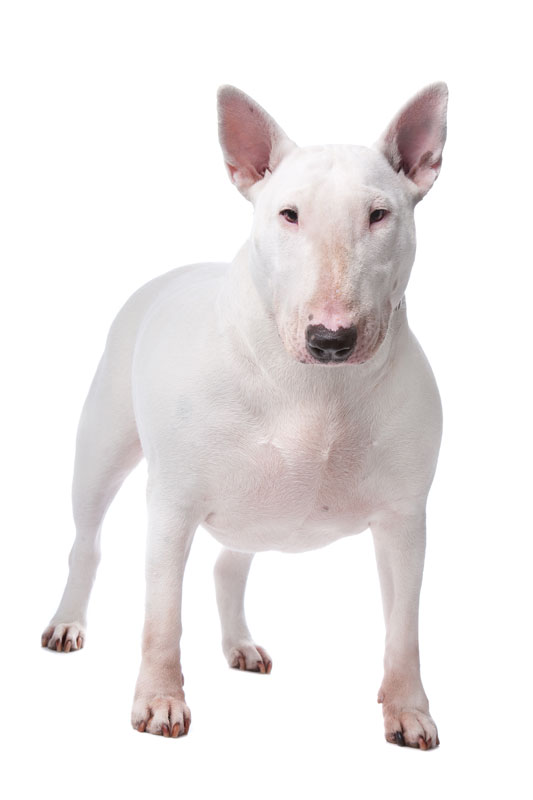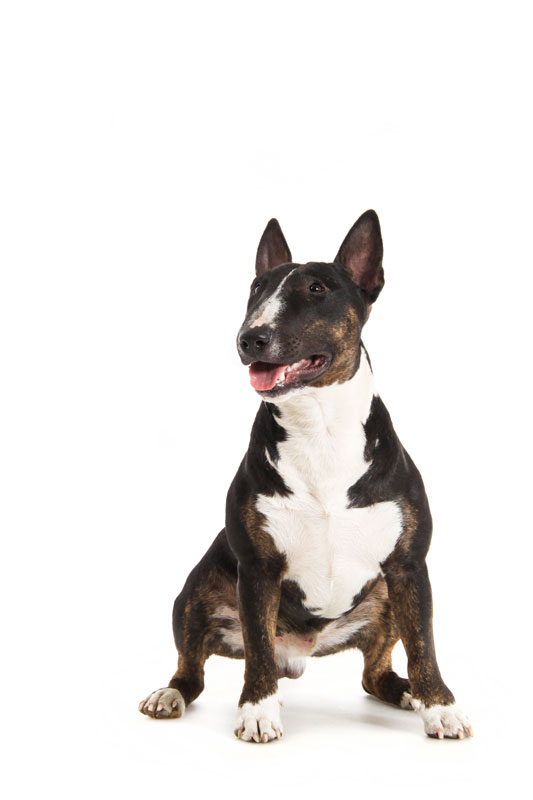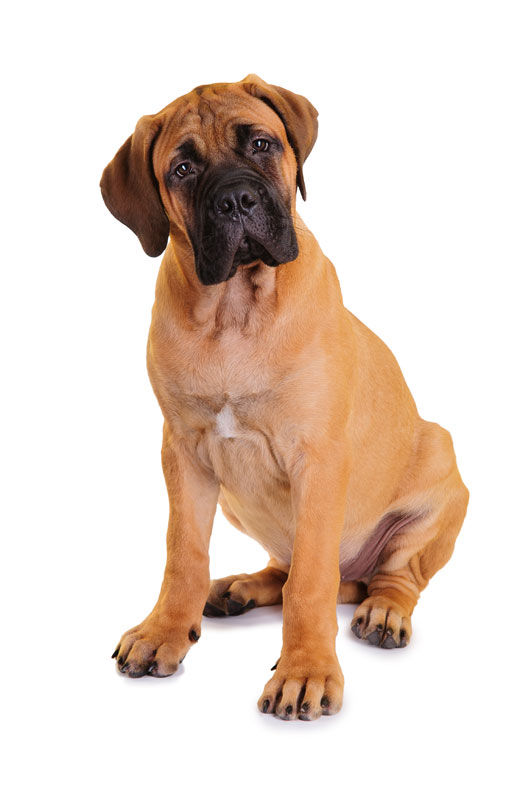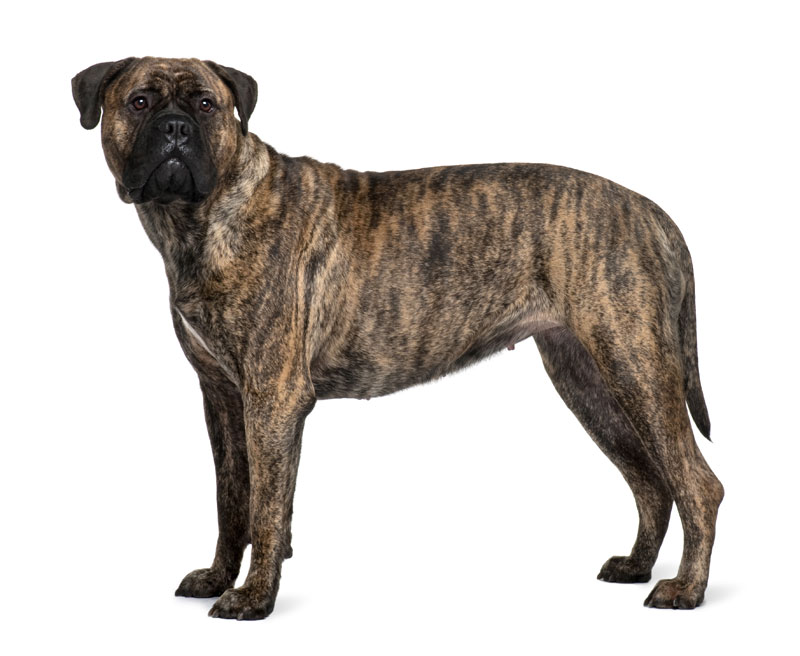Super User
Broholmer
The Broholmer, also called the Danish Mastiff, is a large molosser breed of dog from Denmark, recognized by the Danish Kennel Club and the Fédération Cynologique Internationale. It has been employed as a guard dog in the homes of the wealthy. The breed's numbers dwindled severely during WWII, but the dog made a successful return in the 1970s.
Bruno Jura Hound
The Bruno Jura hound is a domestic dog, developed in the Middle Ages for hunting in the Jura Mountains on the Switzerland-France border.They are found in a variety of colors and have a broad head and heavy wrinkles, which differentiate them from the other Swiss hounds. It is known for hunting fox, hare, and sometimes even small deer. The Bruno Jura Hound is a skilled scent follower and is capable of following the slightest trace of a scent over the rough terrain of the Jura mountains. It needs firm handling if kept solely for companionship.Its size is similar to that of the Schweizer Laufhund, but it differs in the broadness of its head. It is related to the Bloodhound. The life expectancy of Bruno Jura hound is 12–13 years. An adult hound can weigh anywhere from 34 to 44 pounds (15.5–20 kg) and is from usually 17 to 23 inches (43–58 cm) tall.
Also called the Jura Laufhund, this dog is an excellent hunter of fox, hare, and small deer. Closely related to the St. Hubert Jura Hound, its head resembles the neighboring French hounds form which it descends. Not common as a companion, the Bruno Jura Hound needs specialized training if it is to be kept for this purpose. Coming in a variety of colors, the Jura Hound was developed in the Jura Mountains in the Swiss-French border. Its rich coloring, broad head, and heavy wrinkles differentiate this dog from other mountain hounds.
Bucovina Shepherd Dog
The Bucovina Shepherd (Caine Ciobanesc de Bucovina) is a strong and rustic dog which was for many centuries the best partner and companion for the Romanian shepherds in the Carpathian Mountains. The original purpose of this Mountain dog was to guard and protect the herds against predators (wild animals or thieves). Bucovina Shepherd Dogs have become appreciated by people living in cities, who keep them as watch dogs or just as pets, because of their balanced temperament and the kindliness they show to children. There are three types of Romanian shepherd dogs: Mioritic (old name Barac), Carpatin (old name Zăvod) and Bucovina Shepherd. In the Fédération Cynologique Internationale, this breed is known as the Southeastern European Shepherd.
History
The Bucovina Sheepdog is a native breed from the Carpathian Mountains, in Bucovina in the North-East of Romania. In this region, this breed’s individuals are used with great success for guarding herds and property. This dog is also known as Dulau (shepherd’s dog) or Capau.
The first standard was written in 1982 and updated in 2001 by the Asociatia Chinologica Romana (Romanian Kennel Club). The present standard, dating from March 29, 2002, was written and updated according to the model established by the 1987 FCI General Assembly from Jerusalem.The Bucovina Shepherd is only provisionally accepted by the FCI, while its cousins are officially recognised already.
Bull and Terrier
Bull and Terrier is a breed of dog.
History
The Bull and Terrier is a cross between the Old English Bulldog and a variety of Terriers. The anatomy of the Bull and Terrier is the result of selective breeding for the purpose of hunting, dog fighting and Bait (dogs).
Hunting
Most terriers, of the past and present, carried or carry a quarter to an eighth Old English Bulldog blood in them in order, allegedly, to give courage to bear the bites of the prey they are meant to attack. Terriers who were not developed from crosses between the Old English Bulldog and earth-working dogs were of inferior quality and were valued far less.John Henry Walsh wrote in 'The dog, in health and disease, by Stonehenge' (1859):
The terrier as used for hunting is a strong useful little dog, with great endurance and courage, and with nearly as good a nose as the Beagle or Harrier. From his superior courage when crossed with the Bulldog, as most vermin-terriers are, he has generally been kept for killing vermin whose bite would deter the Spaniel or the Beagle, but would only render the terrier more determined in his pursuit of them.
Walsh also wrote of the Fox Terrier:
The field fox-terrier, used for bolting the fox when gone to ground, was of this breed (bull and terrier).
Not only is the Fox Terrier the progeny of the Bull and Terrier, but so is the Airedale Terrier, rat-working terriers, working black and tan terriers, and most all other vermin-hunting terriers.James Rodwell described in his book titled The rat: its history and destructive nature, that the great object, among the various breeders of Bull and Terrier dogs for hunting vermin and rats, was to have them as nearly thorough-bred bull as possible, but at the same time preserving all the outward appearances of the terrier as to size, shape, and colour.
Dog fighting
The Old English Bulldog was bred for bull-baiting. Its life depended on "Go Low, Pin and Hold". Such a breed was unsuitable for dog fighting in the pit. Once an Old English Bulldog got a good grip, there would be little left for the spectators to see, except for two dogs gripping each other, closing their jaws tighter and tighter.Required were quick attacks, new grips, and tricks, which made up the drama of a dog fight that appealed to spectators, gambling, and dog owners. The introduction of English Terrier blood provided longer legs, fiery temperament, and speed, which provided entertaining fights.The crossing of bulldog and terrier produced a dog that no longer belonged to either foundation breed. The new breed was called the Bull and Terrier. With attributes such as ferociousness, aggressiveness, and intelligence, there were few fighting tasks it could not perform better than other breeds of those times.In 1835, with the banning of bait (dogs) the breed was placed in jeopardy of extinction; however, while bull-baiting and bear-baiting laws were enforced, dog fighting flourished, so the Bull and Terrier lived on. Around 1860, the Bull and Terrier breed split into two branches, the pure white Bull Terrier and the coloured forms that lived on for another seventy years in the dog pit until they finally were recognized as a legitimate dog breed called the Staffordshire Bull Terrier.Around the same time, many lower class Irish and Englishmen were emigrating to America with their proto-Staffordshire Bull Terriers. Over time, the descendants of these dogs became taller and heavier. Their masters opted for a dog that was both an aggressive a warrior in the gambling dens of the cities and saloons but also was a working dog, its terrier and bulldog blood from Ireland and the UK proving to be very useful in farm work and in hunting. The breed was officially recognized as the American Pit Bull Terrier, in 1898 and later its close kin the American Staffordshire Terrier in 1936.
Bull Terrier
The Bull Terrier is a dog breed in the terrier family. There is also a miniature version of this breed which is officially known as the Bull Terrier (Miniature).
History
Early in the mid-19th century the "Bull and Terrier" breeds were developed to satisfy the needs for vermin control and animal-based blood sports. The "Bull and Terriers" were based on the Old English Bulldog (now extinct) and one or more of Old English Terrier and "Black and tan terrier", now known as Manchester Terrier. This new breed combined the speed and dexterity of lightly built terriers with the dour tenacity of the Bulldog, which was a poor performer in most combat situations, having been bred almost exclusively for fighting bulls and bears tied to a post. Many breeders began to breed bulldogs with terriers, arguing that such a mixture enhances the quality of fighting. Despite the fact that a cross between a bulldog and a terrier was of high value, very little or nothing was done to preserve the breed in its original form. Due to the lack of breed standards—breeding was for performance, not appearance—the "Bull and Terrier" eventually divided into the ancestors of "Bull Terriers" and "Staffordshire Bull Terriers", both smaller and easier to handle than the progenitor.About 1850, started breeding "Bull and Terriers" with "English White Terriers" (now extinct), looking for a cleaner appearance with better legs and nicer head. In 1862, Hinks entered a bitch called "Puss" sired by his white Bulldog called "Madman" into the Bull Terrier Class at the dog show held at the Cremorne Gardens in Chelsea. Originally known as the "Hinks Breed" and "The White Cavalier", these dogs did not yet have the now-familiar "egg face", but kept the stop in the skull profile.The dog was immediately popular and breeding continued, using Dalmatian, Greyhound, Navarran Pointer, Foxhound and Whippet to increase elegance and agility; and Borzoi and Collie to reduce the stop. Hinks wanted his dogs white, and bred specifically for this. Generally, however, breeding was aimed at increasing sturdiness: three "subtypes" were recognised by judges, Bulldog, Terrier and Dalmatian, each with its specific conformation, and a balance is now sought between the three. The first modern Bull Terrier is now recognised as "Lord Gladiator", from 1917, being the first dog with no stop at all. Due to medical problems associated with all-white breeding, Ted Lyon among others began introducing colour, using Staffordshire Bull Terriers in the early 20th century. Coloured Bull Terriers were recognised as a separate variety (at least by the AKC) in 1936. Brindle is the preferred colour, but other colours are welcome.Along with conformation, specific behaviour traits were sought. The epithet "White cavalier", harking back to an age of chivalry, was bestowed on a breed which while never seeking to start a fight was well able to finish one, while socialising well with its "pack", including children and pups. Hinks himself had always aimed at a "gentleman's companion" dog rather than a pit-fighter—though Bullies were often entered in the pits, with some success.
Bull Terrier (Miniature)
The Bull Terrier (Miniature) is a dog breed with origins in the English White Terrier, the Dalmatian and the Bulldog. The first existence is documented 1872 in The Dogs of British Island.
History
When the Standard breed was first created in 19th century England, it was about the same size as Miniature Bull Terriers. Miniature Bull Terriers were granted membership in the American Kennel Club (AKC) on May 14, 1991 (effective January 1, 1992).
Health
Miniature Bull Terriers are generally quite healthy, but there are hearing, eye, skin, kidney, heart and knee problems in some dogs.
Deafness occurs in both coloured and white Bull Terrier (Miniature). Puppies can be born unilaterally deaf (deaf in one ear) or bilaterally (deaf in both ears.) Deaf dogs should not be bred due to deafness being hereditary. BEAP (or BAER) testing is done on puppies prior to sale to discover which puppies have hearing problems.Bull Terrier (Miniature) are also susceptible to having luxating patellas. This is a knee problem common in small dogs. It can be treated by surgery.Polycystic kidney disease (PKD) and Bull Terrier hereditary nephritis (BTHN) are autosomal dominant diseases. PKD is diagnosed by Ultrasonic scan by a specialist veterinarian. BTHN is diagnosed by a UPC test. Dogs with a score of .3 or below are considered clear of the disease. Clearing breeding stock prior to use ensures that progeny are not affected with the disease.Miniature Bull Terriers are also susceptible to eye problems such as primary Eye proptosis. PLL is a late onset disease which typically affects dogs between the ages of 3 and 7. Younger and older cases are known. During September 2009 a definitive DNA test was released by the Animal Health Trust. This test gives three results: Clear, Carrier, Affected.Aortic valve stenosis and mitral valve dysplasia are heart diseases. Diagnosis is made by colour doppler echocardiography scanning by a specialist veterinarian.The skin of a Miniature can be a problem. Pyotraumatic dermatitis (Hot spot (veterinary medicine)), allergic reactions, and hives can be problematic.
UK and US breed surveys shows an average lifespan of 10-14 years.s
Bulldog
Bulldog is the name for a breed of dog commonly referred to as the English Bulldog. Other Bulldog breeds include the American Bulldog, Old English Bulldog (now extinct), Olde English Bulldogge, and the French Bulldog. The Bulldog is a muscular, heavy dog with a wrinkled face and a distinctive pushed-in nose. The American Kennel Club (AKC), The Kennel Club (UK), and the United Kennel Club (UKC) oversee breeding standards.
Health
A UK survey puts Bulldog life expectancy at 6.5 years, The leading cause of death of Bulldogs in the survey was cardiac related (20%), cancer (18%), and old age (9%). Those that died of old age had an average lifespan of 10 to 11 years.Statistics from the Orthopedic Foundation for Animals indicate that of the 467 Bulldogs tested between 1979 and 2009 (30 years), 73.9% were affected by Hip dysplasia (canine), the highest amongst all breeds. Similarly, the breed has the worst score in the British Veterinary Association/Kennel Club Hip Dysplasia scoring scheme, although sample size were tested in the scheme. Luxating patella is another condition; it affects 6.2% of Bulldogs.Some individuals of this breed are prone to interdigital cysts—cysts that form between the toes. These cause the dog some discomfort, but are treatable either by vet or an experienced owner. They may also suffer from respiratory problems. Other problems can include cherry eye, a protrusion of the inner eyelid (which can be corrected by a veterinarian), Allergy, and hip issues in older Bulldogs.Over 80% of Bulldog litters are delivered by Caesarean section because their characteristically large heads can become lodged in the mother's birth canal. The folds or "rope" on a Bulldog's face should be cleaned daily to avoid infections caused by moisture accumulation. Some Bulldogs' naturally curling tails can be so tight to the body as to require regular cleaning and ointment.Like all dogs, Bulldogs require daily exercise. If not properly exercised it is possible for a Bulldog to become overweight, which could lead to heart and lung problems, as well as stress on the joints.Bulldogs have very small nasal cavities and thus have great difficulty keeping their bodies cool. Bulldogs are very sensitive to heat. Extra caution should be practiced in warmer climates and during summer months. Bulldogs must be given plenty of shade and water, and must be kept out of standing heat. Air conditioning and good ventilation are required to keep them healthy and safe. Bulldogs actually do most of their sweating through the pads on their feet and accordingly enjoy cool floors. Like all brachycephalic or "short faced" breeds, Bulldogs can easily become overheated and even die from hyperthermia. (see Brachycephalic syndrome) They can be big snorters and heavy breathers, and they tend to be loud snorers. Bulldog owners can keep these issues under control by staying aware and protecting their Bulldog(s) from these unsafe conditions.In January 2009, after the BBC documentary Pedigree Dogs Exposed, The Kennel Club introduced revised breed standards for the British Bulldog, along with 209 other breeds, to address health concerns. Opposed by the British Bulldog Breed Council, it was speculated by the press that the changes would lead to a smaller head, fewer skin folds, a longer muzzle, and a taller thinner posture, in order to combat problems with respiration and breeding due to head size and width of shoulders.
Bullenbeisser
The Bullenbeisser (also known as the German Bulldog) was a breed of dog known for its physical strength and agility. The breed was closely related to the Bärenbeisser (some believe that the two breeds were the same (the names mean "Bull-baiting" and "Bear-baiting"), and the Boxer. It was in all its aspects similar to the present Spanish Bulldog and very alike to the Dogo Argentino, not only in aspect, but also in usage. There were two regional varieties, the Brabanter Bullenbeisser and the Danziger Bullenbeisser. The breed is now extinct.
Bullmastiff
The bullmastiff is a large breed of domestic dog, with a solid build and a short muzzle. The bullmastiff shares the characteristics of Molosser dogs, and was originally developed by 19th-century gamekeepers to guard estates. The breed's bloodlines are drawn from the English Mastiff and Old English Bulldog. It was recognized as a purebred dog by the Kennel Club in 1924. They are quiet dogs, and very rarely bark.
History
Bred by English gamekeepers in the 19th century to assist English wardens or gamekeepers guard estates. As a result the bullmastiff is known as the Gamekeeper's Night Dog. The Bullmastiff was a cross of 40% Old English Bulldog (not the short, chubby Bulldog of today) and 60% English Mastiff for its size, strength and loyalty. They bark much less often than other breeds; however, they will bark on alarm. They were also bred to pull things.The bullmastiff was recognized as a pure-bred dog in 1924 by the English Kennel Club. In October, 1933, the American Kennel Club Club recognized the bullmastiff. The first standard for the breed was approved in 1935. The standard has undergone several revisions since then. The most current version is available on the AKC Web site.
Health
A UK survey puts the median lifespan of the bullmastiff at 7 to 8 years old. A bullmastiff will not stop growing until it is about three and a half years of age. Bullmastiffs are prone to certain hereditary diseases including:
* Hip dysplasia (canine), affecting 24.5% of individuals
* Elbow dysplasia, affecting 13.8% of individuals
* Entropion
* Hypothyroidism affecting 2.8% of individuals
* Lymphoma in animals cancer
* Progressive retinal atrophy, a particular problem, since the trait is an Autosomal dominant#Autosomal dominant gene one. Although this has recently been called into question by another other medical team and has been proven there are bullmastiffs with Autosomal Recessive PRA Genes. In America, this is being investigated by the American Bullmastiff Health and Research Committee and the DNA Optigen test only works for dominant so is considered not adequate at this time.
* Arthritis
* BloatCosmetic genetic problems include longhairs and "Dudleys". Both are recessives and not common. The Dudley, named after a notable Bulldog breeder of the 19th century, the Earl of Dudley, is a lack of pigment in the melanistic mask. It can be liver colored or simply not present.
Bully Kutta
The Bully Kutta or Pakistani Mastiff or simply Bully is a descendant of the extinct Alaunt that originated from the Sindh and Punjab regions of Pakistan, where they are the most common guard-dog. Some can be found in India, but they are rarer there. The word Bully is derived from the Punjabi or Urdu/Hindi word Bohli,which means heavily wrinkled, while the word Kutta means dog in Languages of South Asia.
In popular culture
New York Times best-selling author Greg Iles depicted this breed in his 2009 novel, The Devil's Punchbowl.

